Mapping the Emotional Experience of Travel to Understand Cycle-Transit User Behavior
Abstract
:1. Introduction
- What types of emotions do CTUs experience as they travel, what are the reasons behind those emotions, and how do those emotions relate to specific geographic locations?
- How can mapping and understanding these emotions help urban planners comprehend CTU travel behavior and build a more sustainable transportation system?
2. Literature Review
2.1. Happiness Studies: Yielding Insight into the Range of Human Emotions from Psychological Research to Planning Interventions
2.2. Connection between Human Emotions, Travel Behavior, and Place
3. Materials and Methods
3.1. Data
3.2. Context
3.3. Methodology
3.3.1. Phase 1: Analyzing CTU Emotions and Creating Emotional Maps
3.3.2. Phase 2: Understanding Implications of CTU Emotional Maps
4. Results
4.1. Phase 1 Results—CTU Emotions and Emotional Maps
4.1.1. Negative Emotions Prevail amongst CTUs
4.1.2. Four Ways to Map CTU Emotions
4.2. Phase 2 Results: Implications of CTU Emotional Maps in Transportation Planning and Practice
By looking at such maps, we can be aware of [the] conditions of certain roads or intersections, especially if we are not too familiar with all possible routes one could take from point a to point b. These are real comments about the routes or places shown on the map.
5. Discussion
5.1. CTU Emotions—Types, Reasons, and Locations
5.2. Usefulness of CTU Emotional Maps in Transportation Planning
5.3. Limitations and Future Studies
6. Conclusions
Author Contributions
Funding
Acknowledgments
Conflicts of Interest
References
- Thompson, S. Introduction to Happiness and Society. In Oxford Handbook of Happiness; David, S., Boniwell, I., Ayers, A.C., Eds.; Oxford University Press: Oxford, UK, 2012; pp. 427–430. [Google Scholar]
- Hanson, S. The Context of Urban Travel: Concepts and Recent Trends. In The Geography of Urban Transportation; Hanson, S., Giuliano, G., Eds.; The Guilford Press: New York, NY, USA, 2004; pp. 3–29. [Google Scholar]
- U.S. Census Bureau. Modes Less Traveled: Walking and Bicycling to Work in the U.S. 2008–2012. Available online: https://www2.census.gov/library/publications/2014/acs/acs-25.pdf (accessed on 16 May 2019).
- U.S. Bureau of Transportation Statistics. Available online: https://www.bts.gov/content/us-vehicle-miles (accessed on 16 May 2019).
- Meerow, S.; Mitchell, C.L. Weathering the storm: The politics of urban climate change adaptation planning. Environ. Plan. A Econ. Space 2017, 49, 2619–2627. [Google Scholar] [CrossRef]
- Adey, P. Mobility; Routledge: New York, NY, USA, 2010. [Google Scholar]
- Ballas, D.; Dorling, D. The Geography of Happiness. In Oxford Handbook of Happiness; David, S., Boniwell, I., Ayers, A.C., Eds.; Oxford University Press: Oxford, UK, 2012; pp. 465–481. [Google Scholar]
- De Vos, J.; Schwanen, T.; Van Acker, V.; Witlox, F. Travel and Subjective Well-Being: A Focus on Findings, Methods and Future Research Needs. Transp. Rev. 2013, 33, 421–442. [Google Scholar] [CrossRef] [Green Version]
- Morris, E.A.; Zhou, Y. Are long commutes short on benefits? Commute duration and various manifestations of well-being. Travel Behav. Soc. 2018, 11, 101–110. [Google Scholar] [CrossRef]
- Cummins, R.A. Measuring Happiness and Subjective Well-Being. In Oxford Handbook of Happiness; David, S., Boniwell, I., Ayers, A.C., Eds.; Oxford University Press: Oxford, UK, 2012; pp. 185–200. [Google Scholar]
- Flamm, B.J.; Rivasplata, C.R. Public transit catchment areas: The curious case of cycle-transit users. Transport. Res. Rec. 2014, 2419, 101–108. [Google Scholar] [CrossRef]
- Mulgan, G. Well-Being and Public Policy. In Oxford Handbook of Happiness; David, S., Boniwell, I., Ayers, A.C., Eds.; Oxford University Press: Oxford, UK, 2012; pp. 517–534. [Google Scholar]
- Pfeiffer, D.; Cloutier, S. Planning for happy neighborhoods. J. Am. Plan. Assoc. 2016, 82, 267–279. [Google Scholar] [CrossRef]
- Vitterso, J. Introduction to Psychological Definitions of Happiness. In Oxford Handbook of Happiness; David, S., Boniwell, I., Ayers, A.C., Eds.; Oxford University Press: Oxford, UK, 2012; pp. 155–160. [Google Scholar]
- Plutchik, R. The nature of emotions: Human emotions have deep evolutionary roots, a fact that may explain their complexity and provide tools for clinical practice. Am. Sci. 2001, 89, 344–350. [Google Scholar] [CrossRef]
- Keiser, B.E. Still feeling our way toward sentiment analysis. Online Search. 2015, 39, 24–28. [Google Scholar]
- Mohammad, S.M.; Turney, P.D. Crowdsourcing a Word-Emotion Association Lexicon. Comput. Intell. 2013, 29, 436–465. [Google Scholar] [CrossRef]
- Kwan, M.P. Affecting Geospatial Technologies: Toward a Feminist Politics of Emotion. Prof. Geogr. 2007, 59, 22–34. [Google Scholar] [CrossRef]
- Anderson, K.; Smith, S.J. Emotional geographies. Trans. Inst. Brit. Geogr. 2001, 26, 7–10. [Google Scholar] [CrossRef]
- Diener, E. Subjective well-being: The science of happiness and a proposal for a national index. Am. Psychol. 2000, 55, 34–43. [Google Scholar] [CrossRef] [PubMed]
- Ettema, D.; Gärling, T.; Olsson, L.E.; Friman, M. Out-of-home activities, daily travel, and subjective well-being. Transp. Res. Part A Policy Pract. 2010, 44, 723–732. [Google Scholar] [CrossRef]
- Schiefelbusch, M. Rational planning for emotional mobility? The case of public transport development. Plan. Theory 2010, 9, 200–222. [Google Scholar] [CrossRef]
- Sheller, M. Automotive emotions: Feeling the car. Theor. Cult. Soc. 2004, 21, 221–242. [Google Scholar] [CrossRef]
- Sheller, M.; Urry, J. The new mobilities paradigm. Environ. Plan. A 2006, 38, 207–226. [Google Scholar] [CrossRef]
- Urry, J. Connections. Environ. Plan. D 2004, 22, 27–37. [Google Scholar] [CrossRef]
- Morris, E.A.; Guerra, E. Mood and mode: Does how we travel affect how we feel? Transportation 2015, 42, 25–43. [Google Scholar] [CrossRef]
- Morris, E.A.; Guerra, E. Are we there yet? Trip duration and mood during travel. Transp. Res. Part F Traffic Psychol. Behav. 2015, 33, 38–47. [Google Scholar] [CrossRef]
- Olsson, L.E.; Gärling, T.; Ettema, D.; Friman, M.; Fujii, S. Happiness and satisfaction with work commute. Soc. Indic. Res. 2013, 111, 255–263. [Google Scholar] [CrossRef]
- Ettema, D.; Gärling, T.; Eriksson, L.; Friman, M.; Olsson, L.E.; Fujii, S. Satisfaction with travel and subjective well-being: Development and test of a measurement tool. Transp. Res. Part F Traffic Psychol. Behav. 2011, 14, 167–175. [Google Scholar] [CrossRef]
- Ettema, D.; Gärling, T.; Olsson, L.E.; Friman, M.; Moerdijk, S. The road to happiness: Measuring Dutch car drivers’ satisfaction with travel. Transp. Policy 2013, 27, 171–178. [Google Scholar] [CrossRef]
- Nold, C. San Francisco Emotion Map. 2007. Available online: http://www.emotionmap.net (accessed on 22 July 2018).
- Nold, C. Emotional Cartography: Technologies of the Self. 2009. Available online: http://www.emotionalcartography.net (accessed on 22 July 2018).
- Keenan, K. Place ontologies and a new mobilities paradigm for understanding awareness of vulnerability to terrorism in American cities. Urban Geogr. 2014, 35, 357–377. [Google Scholar] [CrossRef]
- Tuan, Y. Space and Place: The Perspective of Experience; University of Minnesota Press: Minneapolis, MN, USA, 1977. [Google Scholar]
- Philadelphia Pedestrian and Bicycle Plan. Available online: http://www.phila.gov/CityPlanning/plans/Pedestrian%20and%20Bicycle%20Plan/Ped_B ke_Plan_ProgressReport2015.pdf (accessed on 3 March 2019).
- U.S. Census Bureau ACS 2015 Estimates. Available online: https://www.census.gov/ (accessed on 11 November 2017).
- Krippendorff, K. Content Analysis: An Introduction to its Methodology, 2nd ed.; Sage Publications: Thousand Oaks, CA, USA, 2004. [Google Scholar]
- Krippendorff, K. Reliability in Content Analysis: Some Common Misconceptions and Recommendations. Hum. Commun. Res. 2004, 30, 411–433. [Google Scholar] [CrossRef]
- Cope, M.S.; Elwood, sS. Qualitative GIS: A Mixed Methods Approach; Sage Publications: Thousand Oaks, CA, USA, 2009. [Google Scholar]
- Dennis, S.F.J. Prospects for qualitative GIS at the intersection of youth development and participatory urban planning. Environ. Plan. A 2006, 38, 2039–2054. [Google Scholar] [CrossRef]
- Eizenberg, E.; Shilon, M. Pedagogy for the new planner: Refining the qualitative toolbox. Environ. Plan. B Plan. Des. 2016, 43, 1118–1135. [Google Scholar] [CrossRef]
- Meenar, M.R. Using participatory and mixed-methods approaches in GIS to develop a Place-Based Food Insecurity and Vulnerability Index. Environ. Plan. A Econ. Space 2017, 49, 1181–1205. [Google Scholar] [CrossRef]
- Perkins, C. Performative and Embodied Mapping. In International Encyclopedia of Human Geography; Kitchin, R., Thrift, N., Eds.; Elsevier: Oxford, UK, 2009; pp. 126–132. [Google Scholar]
- Pánek, J.; Benediktsson, K. Emotional mapping and its participatory potential: Opinions about cycling conditions in Reykjavík, Iceland. Cities 2017, 61, 65–73. [Google Scholar] [CrossRef]
- Griffin, A.L.; Mcquoid, J. At the intersection of maps and emotion: The challenge of spatially representing experience. Kartogr. Nachr. 2012, 6, 291–299. [Google Scholar]
- Jung, J. Code clouds: Qualitative geovisualization of geotweets. Can. Geogr. 2015, 59, 52–68. [Google Scholar] [CrossRef]
- Forsyth, A.; Krizek, K. Urban Design: Is there a Distinctive View from the Bicycle? J. Urban Des. 2011, 16, 531–549. [Google Scholar] [CrossRef]
- Heinen, E.; Van Wee, B.; Maat, K. Commuting by Bicycle: An Overview of the Literature. Transp. Rev. 2010, 30, 59–96. [Google Scholar] [CrossRef]
- Møller, M.; Hels, T. Cyclists’ perception of risk in roundabouts. Accid. Anal. Prev. 2008, 40, 1055–1062. [Google Scholar] [CrossRef]
- Carver, A.; Campbell, K.; Baur, L.; Salmon, J.; Garnett, S.; Crawford, D. How Do Perceptions of Local Neighborhood Relate to Adolescents’ Walking and Cycling? Am. J. Health Promot. 2005, 20, 139–147. [Google Scholar] [CrossRef]
- Hunt, J.D.; Abraham, J.E. Influences on bicycle use. Transportation 2007, 34, 453–470. [Google Scholar] [CrossRef]
- Fraser, S.D.; Lock, K. Cycling for transport and public health: A systematic review of the effect of the environment on cycling. Eur. J. Public Health 2010, 21, 738–743. [Google Scholar] [CrossRef]
- Monsere, C.; Dill, J.; McNeil, N.; Clifton, K.; Foster, N.; Goddard, T.; Berkow, M.; Gilpin, J.; Voros, K.; Van Hengel, D.; et al. Lessons from the Green Lanes: Evaluating Protected Bike Lanes in the U.S. Natl. Inst. Transp. Communities. 2014. Available online: https://pdxscholar.library.pdx.edu/cgi/viewcontent.cgi?referer=https://scholar.google.com/&httpsredir=1&article=1143&context=cengin_fac (accessed on 25 August 2019).[Green Version]
- Furness, Z. One Less Car: Bicycling and the Politics of Automobility; Temple University Press: Philadelphia, PA, USA, 2010. [Google Scholar]
- Gatersleben, B.; Uzzell, D. Affective appraisals of the daily commute: Comparing perceptions of drivers, cyclists, walkers, and users of public transport. Environ. Behav. 2007, 39, 416–431. [Google Scholar] [CrossRef]
- Delaware Valley Regional Planning Commission. “RideScore: A Screening Tool for Identifying Candidate Stations for Bicycle Facility Investment”. Available online: https://dvrpc.org/webmaps/RideScore/ (accessed on 15 August 2019).
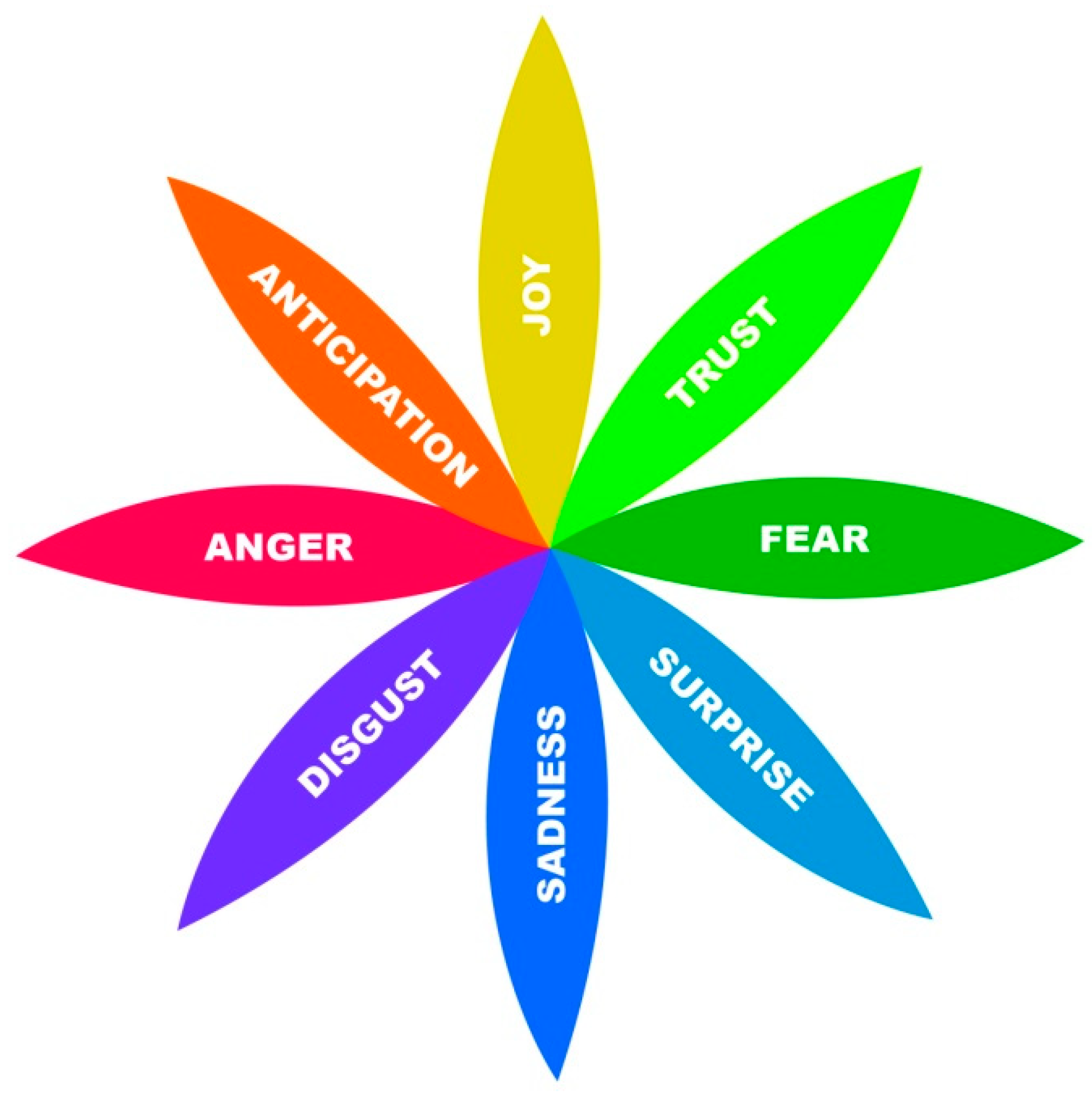
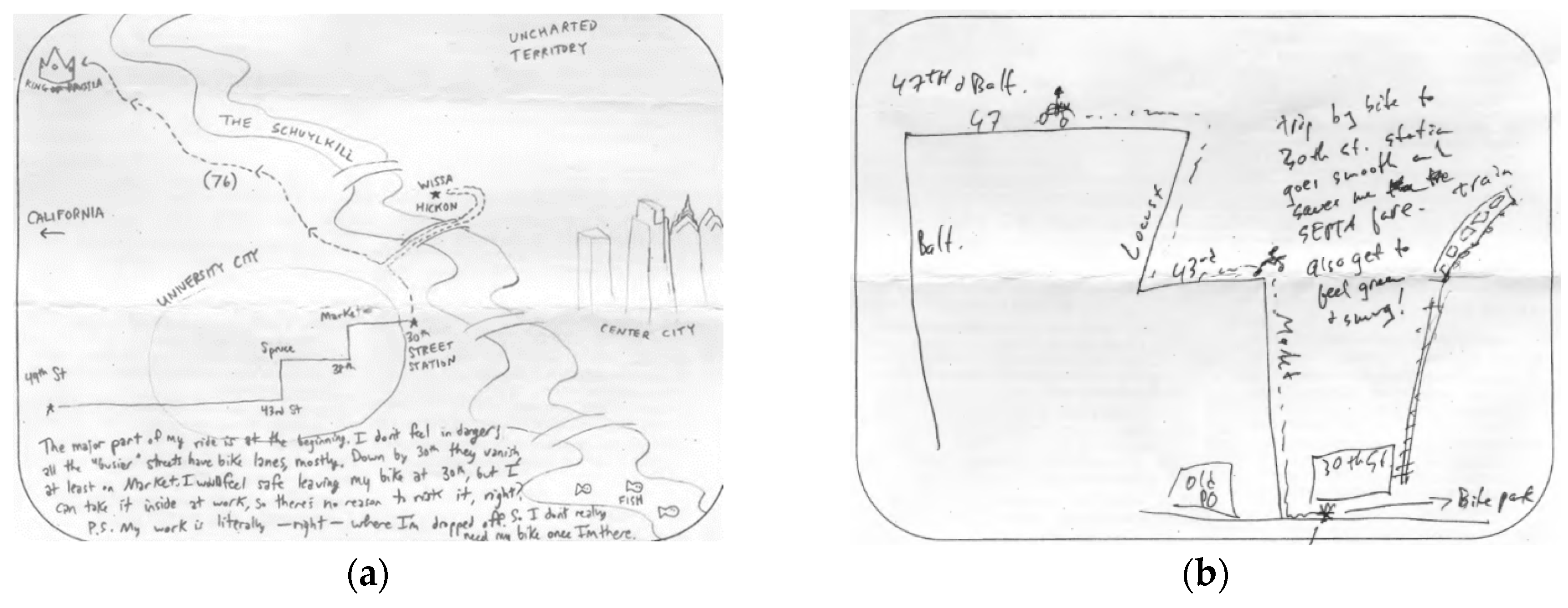
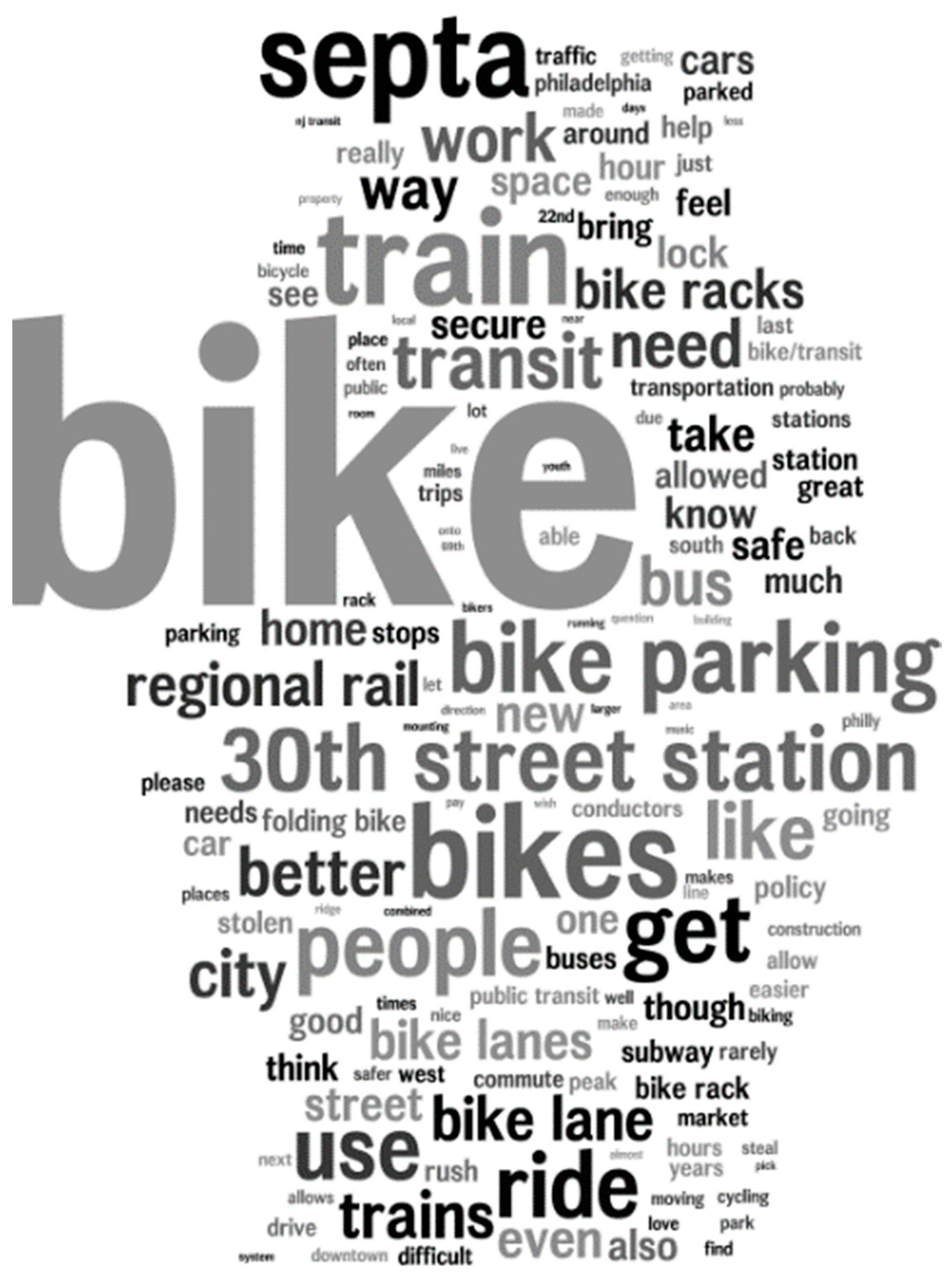
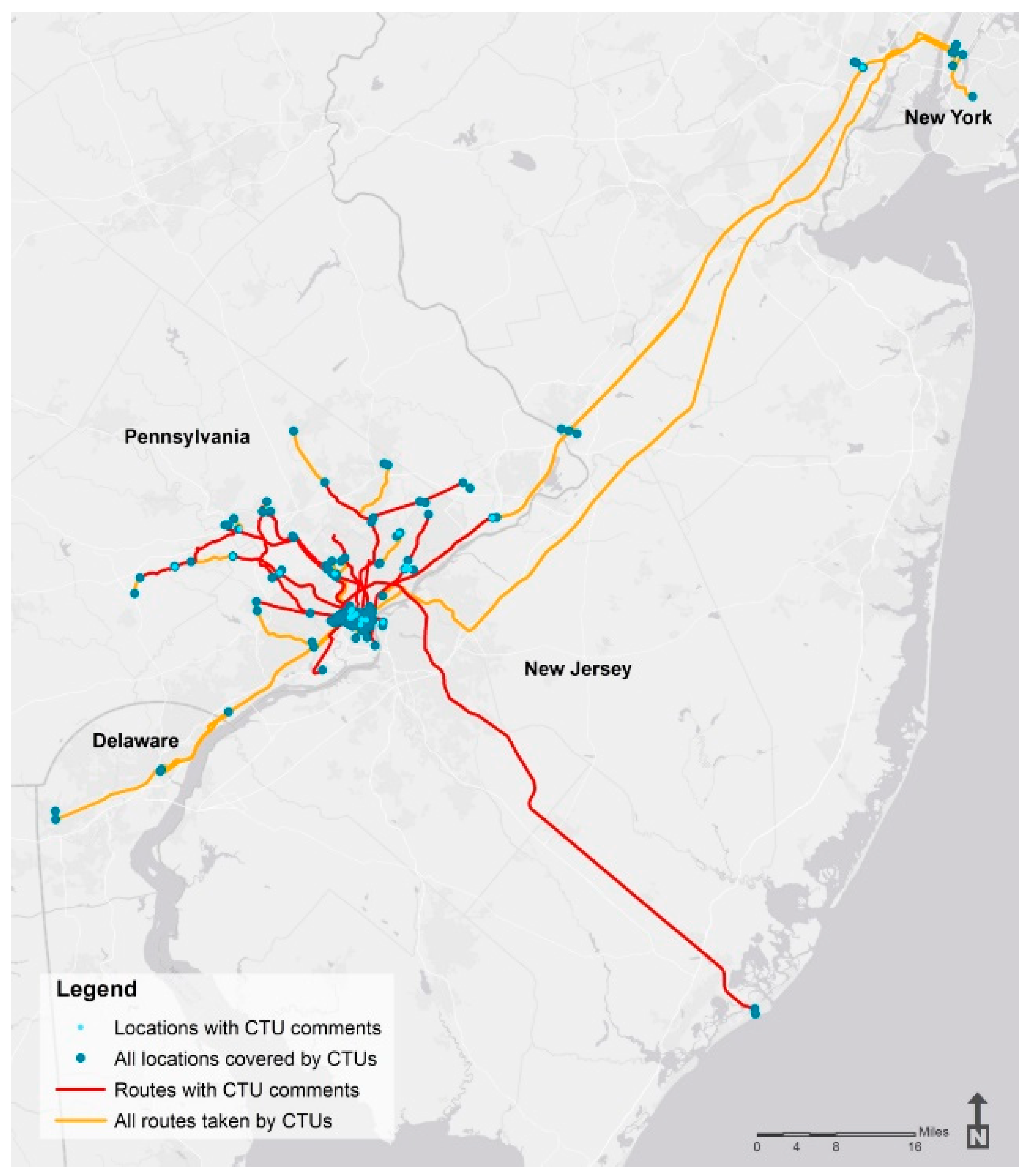
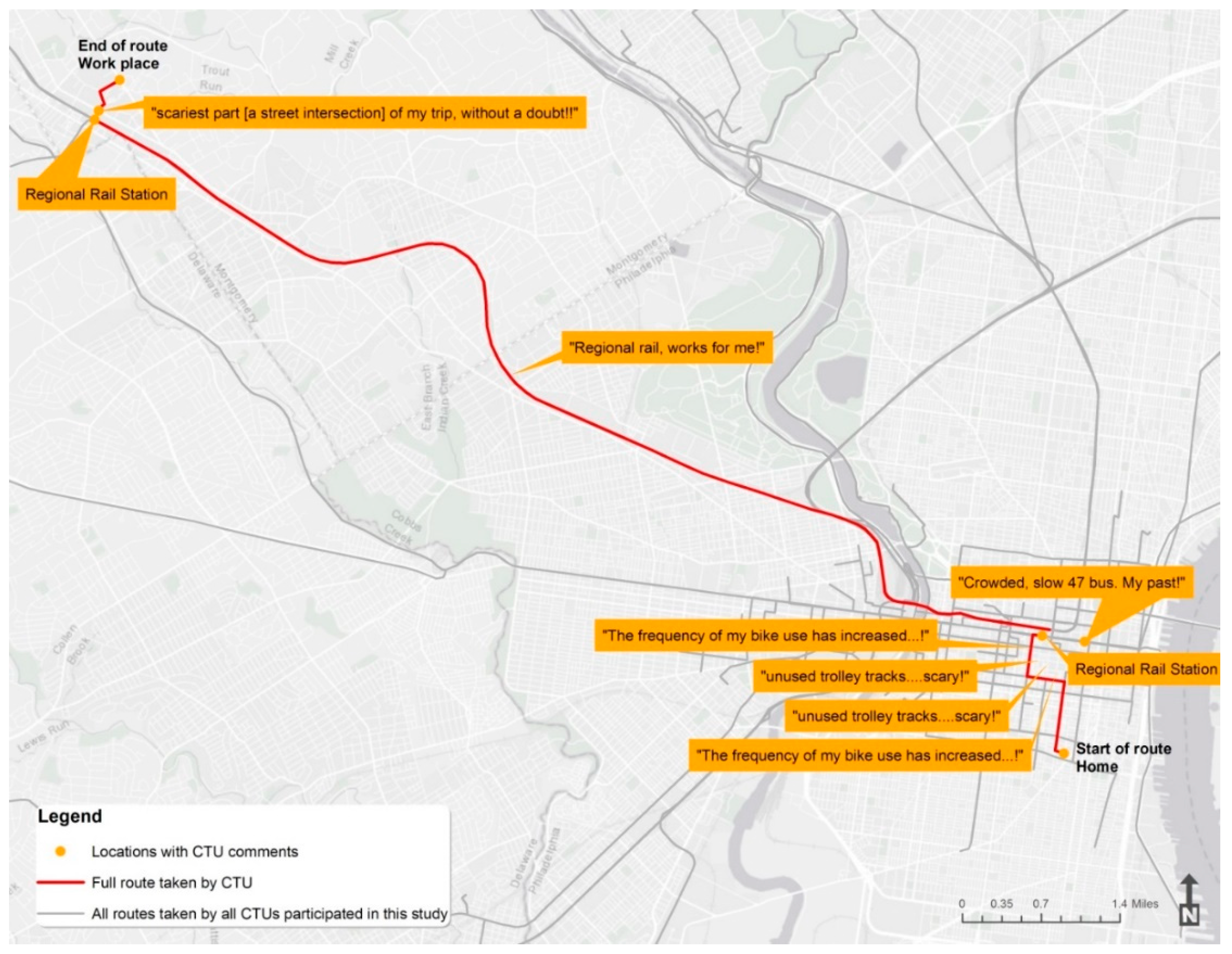
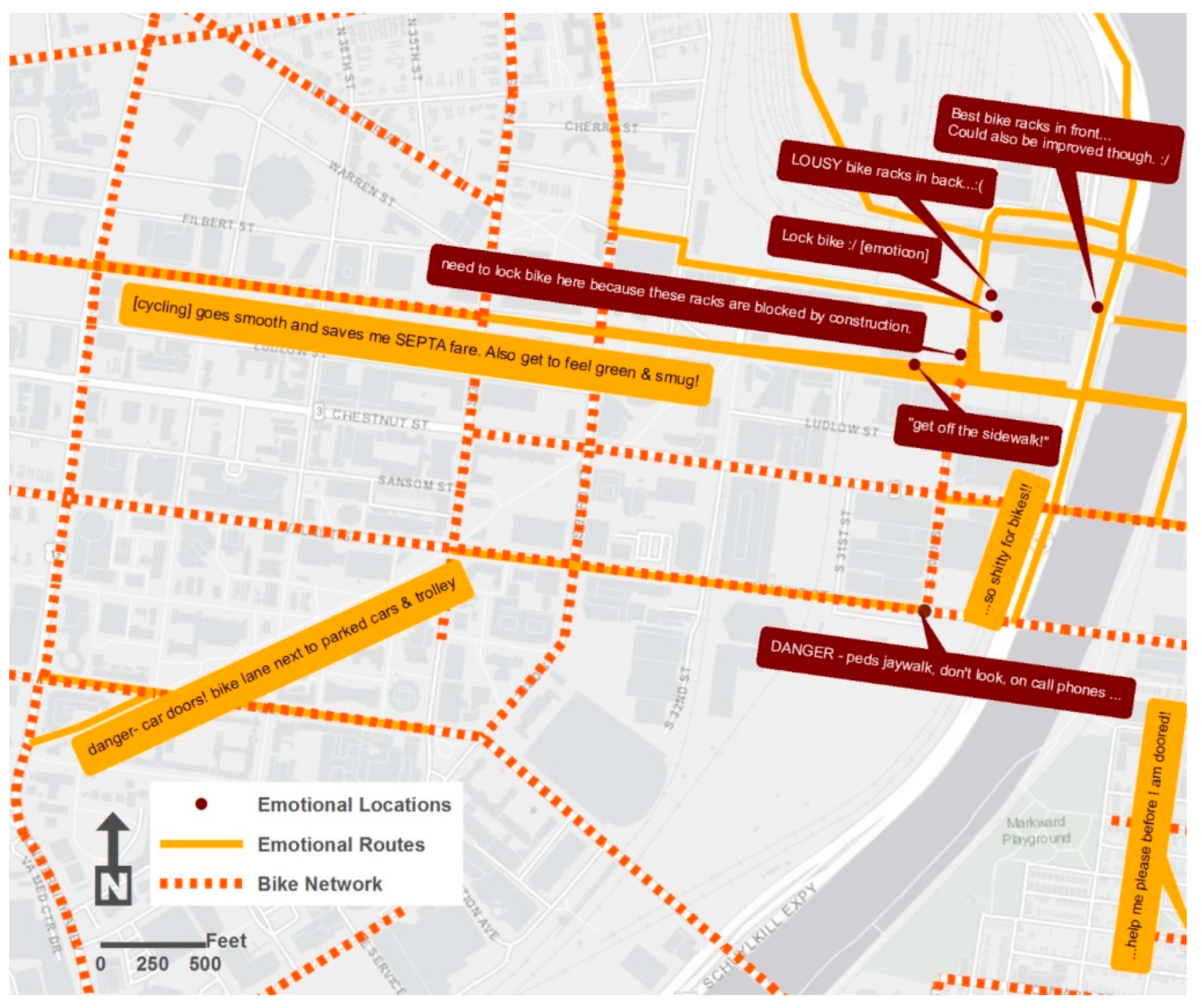
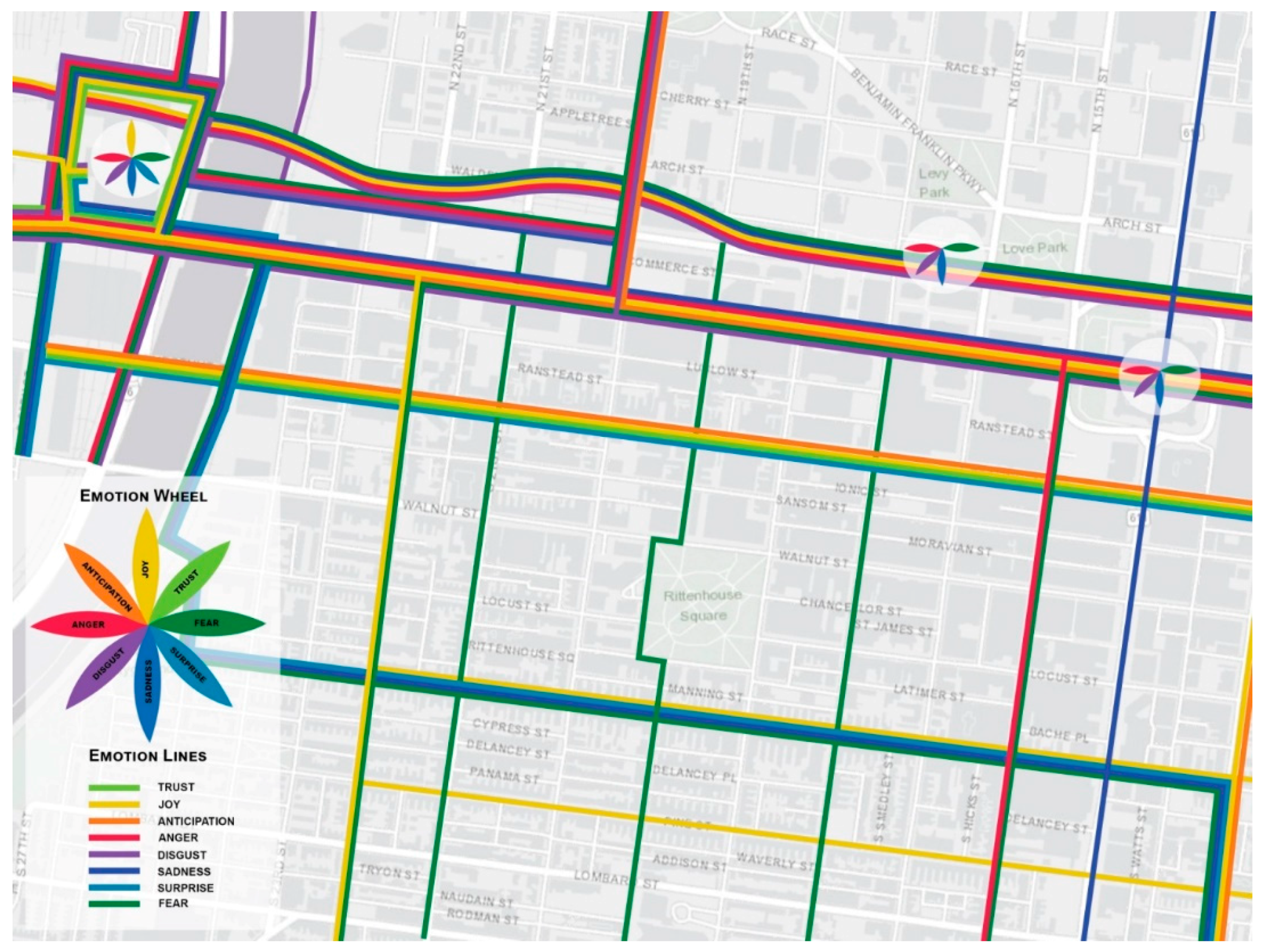
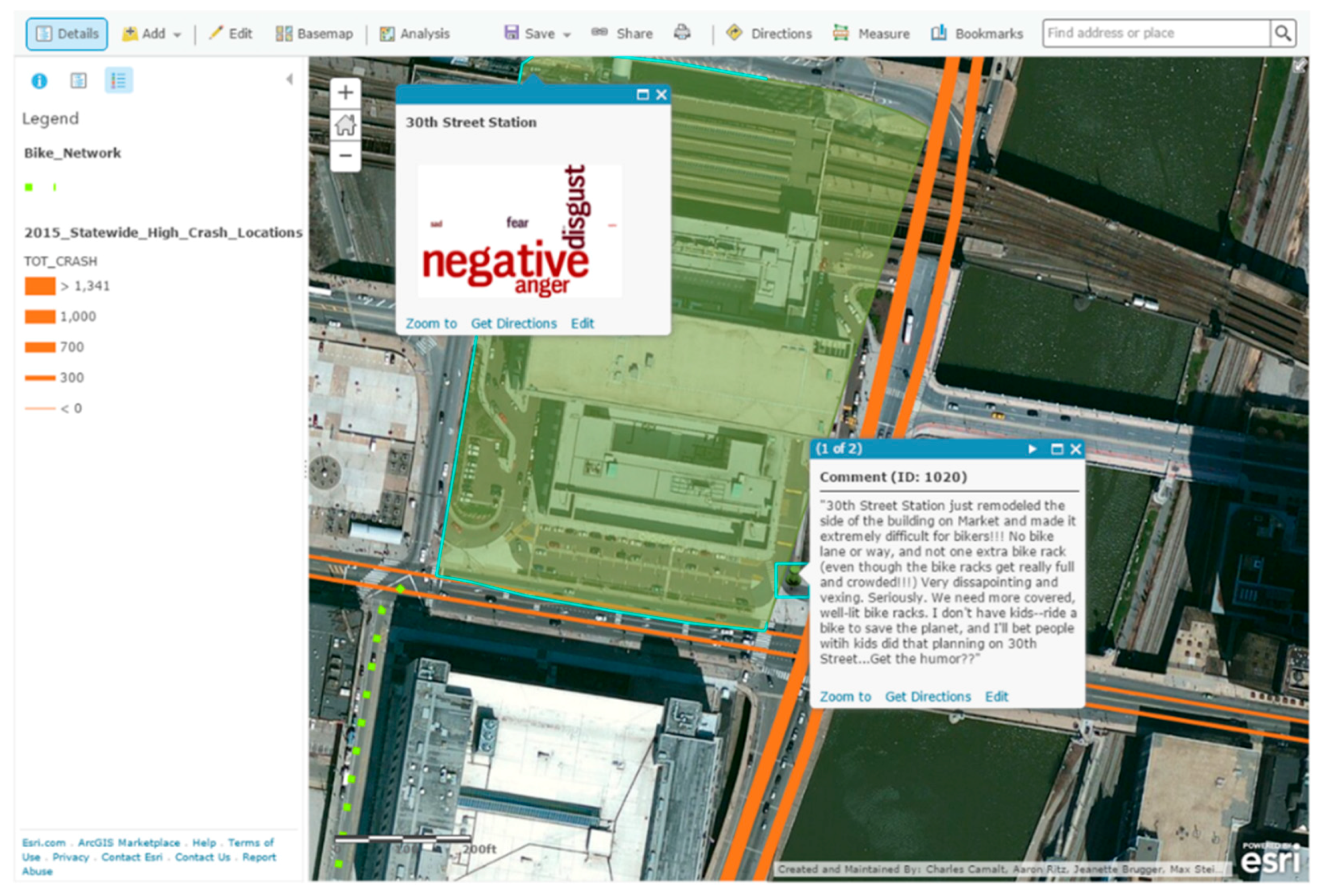
| Demographic and Socioeconomic Characteristics of Survey Respondents (N = 74) | |||||
|---|---|---|---|---|---|
| Characteristic | Number (%) | Characteristic | Number (%) | Characteristic | Number (%) |
| Gender | Marital Status | Highest Educ. Attainment | |||
| Male | 58 (78%) | Married/Domestic partner | 28 (38%) | Less than high sch. | 3 (4%) |
| Female | 14 (19%) | Single | 36 (49%) | High School or GED | 6 (8%) |
| No Answer | 2 (3%) | Divorced or separated | 3 (4%) | Associate degree | 7 (9%) |
| Age | Widowed | 1 (1%) | Bachelor’s degree | 28 (38%) | |
| 19–25 | 12 (16%) | No Answer | 6 (8%) | Graduate | 27(36%) |
| 26–35 | 24 (33%) | No answer | 3 (4%) | ||
| 36–45 | 17 (23%) | Race and Ethnicity | |||
| 46–55 | 12 (16%) | White | 55 (74%) | Access to car | |
| 56–65 | 8 (11%) | African American/Black | 7 (9%) | Yes | 45 (61%) |
| No Answer | 1 (1%) | Asian | 3 (4%) | No | 27 (36%) |
| Income ($) | Two or more races | 3 (4%) | No Answer | 2 (3%) | |
| <20,000 | 10 (14%) | Hispanic or Latino/a | 2 (3%) | ||
| 20,000–40,000 | 14 (19%) | No Answer | 4 (5%) | License to drive | |
| 40,001–60,000 | 10 (14%) | Yes | 57 (77%) | ||
| 60,001–80,000 | 14 (19%) | Household Size (persons) | No | 13 (18%) | |
| 80,001–100,000 | 3 (4%) | Maximum | 9 | No Answer | 4 (5%) |
| >100,000 | 15 (20%) | Minimum | 1 | ||
| No answer | 8 (11%) | Average | 2.6 | ||
| Responses to Open-Ended Questions | |||
| Comments | 62 (84%) | ||
| No Comments | 12 (16%) | ||
| Map | 59 (80%) | ||
| No Map | 15 (20%) | ||
| Of those respondents who wrote comments, either in the text box or on the map | |||
| Sentiments | Emotions | ||
| Positive | 31 | Anger | 34 |
| Negative | 50 | Disgust | 32 |
| Of those respondents who made comments | Fear | 32 | |
| No sentiments | 4 | Sadness | 29 |
| No emotions | 6 | Joy | 24 |
| Neither sentiments nor emotions | 3 | Anticipation | 18 |
| Trust | 17 | ||
| Surprise | 6 | ||
| Theme | Definition | Sample Keywords or Phrases | Count |
|---|---|---|---|
| On-board facilities | Discusses issues related to facilities on transit vehicles (e.g., bus, train). | Problems on-board, lack of on-board facilities, bike-on-rail restrictions, on-board bike rack, “tolerated not welcomed” by transit staff, transit staff misinformed about on-board bike policy, unprofessional transit staff, lack of “defer to cyclists” signage on-board (like for elderly), rude bus drivers, annoying passengers, difficulty securing bike on-board. | 37 |
| Bike Parking and Security | Discusses issues related to bike parking and theft. | Bike rack, bike parking, makeshift parking, missing train due to parking issues, parking disrupted by construction, theft, attempted theft, bike lock, anti-theft cameras. | 35 |
| Road Conditions | Discusses built environment issues such as bike lane quality, intersection design, as well as dangers posed by other road users. | Dangerous bike lanes, getting “doored”, trolley tracks, careless pedestrians, jaywalking, cell phone distraction, cars in bike lane, dangerous intersection, lack of crosswalks, buffered bike lanes. | 25 |
| Commuter Adaptations | Discusses when CTUs had to adapt in order to continue cycling, including purchasing folding bikes or arranging for in-office parking. | Folding bike, bike-on-car segment, in-office bike parking. | 10 |
| Station Facilities | Discusses non-parking amenities at transit stations and difficulties navigating built environment at stations with bikes. | Navigating stairs, bad shelters, bad rack placement, narrow doorways, platform/train levels. | 8 |
| Transit Logistics | Discusses issues of bus schedules, timeliness, and schedule integration of transit modes. | Bad bus connectivity, bad bus schedule integration, late train, infrequent bus schedules. | 6 |
| Conditional Use of Transit | Discusses when some users decide to take transit conditionally due to issues such as darkness, weather, and variability of transit schedules. | Resorting to transit in rain, transit: Rarely resorted to, varying routes depending on darkness, long bike ride to work/longer train ride home. | 6 |
| “Type 1” (CTU Trips) Maps Can Effectively Convey an Emotional Account of a Journey | “Type 2” (CTU Comments) Maps Can Effectively Convey a Set of Opinions on Routes and Locations | “Type 3” (CTU Emotions) Maps Can Effectively Convey CTU Emotions Related to Routes and Locations | “Type 4” (CTU Emotional Spaces) Maps Can Effectively Convey a Set of Opinions on Specific Locations | |||||
|---|---|---|---|---|---|---|---|---|
| n | % | n | % | n | % | n | % | |
| Yes | 10 | 40 | 13 | 52 | 10 | 40 | 12 | 48 |
| Somewhat | 14 | 56 | 9 | 36 | 10 | 40 | 9 | 36 |
| No | 1 | 4 | 3 | 12 | 5 | 20 | 4 | 16 |
| Total | 25 | 100 | 25 | 100 | 25 | 100 | 25 | 100 |
© 2019 by the authors. Licensee MDPI, Basel, Switzerland. This article is an open access article distributed under the terms and conditions of the Creative Commons Attribution (CC BY) license (http://creativecommons.org/licenses/by/4.0/).
Share and Cite
Meenar, M.; Flamm, B.; Keenan, K. Mapping the Emotional Experience of Travel to Understand Cycle-Transit User Behavior. Sustainability 2019, 11, 4743. https://doi.org/10.3390/su11174743
Meenar M, Flamm B, Keenan K. Mapping the Emotional Experience of Travel to Understand Cycle-Transit User Behavior. Sustainability. 2019; 11(17):4743. https://doi.org/10.3390/su11174743
Chicago/Turabian StyleMeenar, Mahbubur, Bradley Flamm, and Kevin Keenan. 2019. "Mapping the Emotional Experience of Travel to Understand Cycle-Transit User Behavior" Sustainability 11, no. 17: 4743. https://doi.org/10.3390/su11174743
APA StyleMeenar, M., Flamm, B., & Keenan, K. (2019). Mapping the Emotional Experience of Travel to Understand Cycle-Transit User Behavior. Sustainability, 11(17), 4743. https://doi.org/10.3390/su11174743






